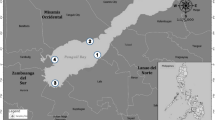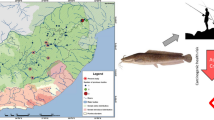Abstract
Along the Alexandria coast of the Egyptian Mediterranean Sea, five edible species of bivalve molluscs and one gastropoda species (Mactra coralline, Ruditapes decussates, Paphia undulate, Venerupis rhomboids, Crista pectinata and Coralliophila meyendorffi) were analyzed for content of metals (Cadmium, Chromium, Lead, Cobalt and Nickel) in the muscle and in the sediments where they live. The potential health risks of metals to humans via consumption of seafood were assessed by estimated daily intake and target hazard quotient. Significant positive correlations (p < 0.05) were obtained between tissue concentrations for all pairs of metals, with the exception of Cadmium. Significant positive correlations were also obtained for the concentrations of Cd and Ni in tissues of all studied species relative to their concentrations in surface sediments. However, correlations between tissue and sediment concentrations for Chromium, Lead and Cobalt were negative. Ruditapes decussates and C. meyendorffi had the highest values for the summed target hazard quotient and may pose a potential risk to local inhabitants through their consumption in the diet. The potential risk would arise from exposure to high tissue concentrations of Cd and Pb, which exceeded published guidelines for safety of seafood products in some cases. Chromium contributed a considerable fraction of the total target hazard quotient for all metals combined, but did not exceed the published guidelines. Cobalt and Ni did not contribute greatly overall to the target hazard quotient, except in the case of Ni in V. rhomboids.

Similar content being viewed by others
References
Anon (1994) Microwave digestion applications manual, CEM, USA
ATSDR, Agency for Toxic Substances and Disease Registry (2000) Toxicologic profile for arsenic. Agency for toxic substances and disease registry, Atlanta, GA
ATSDR, Agency for Toxic Substances and Disease Registry (2004) Cobalt toxicological profile. http://www.atsdr.cdc.gov/toxproiles/tp33.html Accessed 24 Oct 2004
Baudrimont M, Schäfer J, Marie V, Maury-Brachet R, Bossy C, Boudou A, Blanc G (2005) Geochemical survey and metal bioaccumulation of three bivalve species (Crassostrea gigas, Cerastoderma edule and Ruditapes philippinarum) in the Nord Médoc salt marshes (Gironde estuary, France). Sci Total Environ 337:265–280
CA OEHHACalifornia Office of Environmental Health Hazard Assessment (2008) California EPA, proposition 65 safe harbor levels: no significant risk levels for carcinogens and maximum allowable dose levels for chemicals causing reproductive toxicity. January 2008. http://www.oehha.ca.gov/prop65/pdf/feb2008statusreport.pdf. Accessed 2 Sept 2008
Calabrese EJ, Canada AT, Sacco C (1985) Trace elements and public health. Ann Rev Pub Health 6:131–146
Chen D, Zhang M, Shrestha S (2006) Compositional characteristics and nutritional quality of Chinese mitten crab (Eriocheir sinensis). Food Chem 103:1343–1349
Dawoud S (2005) An analysis of food consumption patterns in Egypt. Aus dem institute für Ernährungswirtschaft und verbrauchslehre der christian-albrechts-universität zu kiel
Egyptian Organization for Standardization (1993) Egyptian standard, maximum levels for heavy metal concentrations in food. ES 2360-1993,UDC:546.19:815.Egypt
European Communities (EC) (2001) Commission regulation (EC) No 466/2001 of 8 March 2001 setting maximum levels for certain contaminants in foodstuffs. Official Journal of the European Communities L77
FAO (1983) Compilation of legal limits for hazardous substances in fish and fishery products. FAO Fishery Circular No. 464, 764, pp 5–100
FAO (2005) Statistical databases. http://faostat.fao.org
FAO (2007) The state of world fisheries and aquaculture 2006, Rome, Italy, p 162
Food and Nutrition Board (2004) Dietary reference intakes (DRIs): tolerable upper intake levels (UL), elements. Food and Nutrition Board, Institute of Medicine. National Academies Press, Washington
Islam MD, Tanaka M (2004) Impacts of pollution on coastal and marine ecosystems including coastal and marine fisheries and approach for management: a review and synthesis. Mar Pollut Bull 48:624–649
Loring DH, Rantala RTT (1992) Manual for geochemical analysis. Earth Sci Rev 32:235–283
Luckey TD, Venugopal B (1977) Metal toxicity in mammals. Plenum Press, New York
NAS-NRC, National Academy of Sciences-National Research Council (1982) Drinking water and health, vol 4. National Academic Press, Washington, pp 299
NSF, National Science Foundation (2006) American National Standards #173 for dietary supplements. NSF International, Ann Arbor
Santos EE, Lauria DC, Silveira PCL (2004) Assessment of daily intake of trace elements due to consumption of foodstuffs by adult inhabitants of Rio de Janeiro City. Sci Total Environ 327:69–79
Topcuoglu S, Kirbasoglu Ç, Gũngŏr N (2002) Metals in organisms and sediments from Turkish coast of the Black Sea. Environ Int 1069:1–8
Underwood EJ (1977) Trace elements in human and animal nutrition, 4th edn. Academic, New York
Us EPA (2000) Risk-based concentration table. United States Environmental Protection Agency, Philadelphia
USEPA (1997) Integrated risk information system-database. United States Environmental Protection Agency, Washington
USEPA (2007) Integrated risk information system-database. Philadelphia PA; Washington, DC
Usero J, Morillo J, Gracia I (2005) Metals concentrations in mollusca from the Atlantic coast of southern Spain. Chemosphere 59:1175–1181
USFDA (1993a) Food and drug administration. Guidance document for chromium in shellfish. DHHS/PHS/FDA/CFSAN/Office of Seafood, Washington, DC
USFDA (1993b) Food and drug administration. Guidance document for nickel in shellfish. DHHS/PHS/FDA/CFSAN/Office of Seafood, Washington, D.C
WHO (1989) Evaluation of certain food additives and contaminants. 33rd Report of the Joint FAO/WHO expert committee on food additives. Technical Report Series Geneva
WHO (1996) Chromium in drinking-water, guidelines for drinking water quality, vol 2, 2nd edn. World Health Organization, Geneva
WHO (2005) Background document for development of WHO guidelines for drinking-water quality, 3rd edn. WHO, Geneva, p 30
Zalloua PA, Hsua Y, Terwedowa H, Zangc T, Genfu Tang DW, Li Z (2007) Impact of seafood and fruit consumption on bone mineral density. Maturitas 56:1–11
Acknowledgments
The author sincerely thanks Prof. Dr. Mohamed El Komi, Professor of Bottom Fauna in Marine Hydrobiology Lab at the National Institute of Oceanography and Fisheries, for his support in the classification and identification of the shellfish species.
Author information
Authors and Affiliations
Corresponding author
Rights and permissions
About this article
Cite this article
Abdallah, M.A.M. Bioaccumulation of Heavy Metals in Mollusca Species and Assessment of Potential Risks to Human Health. Bull Environ Contam Toxicol 90, 552–557 (2013). https://doi.org/10.1007/s00128-013-0959-x
Received:
Accepted:
Published:
Issue Date:
DOI: https://doi.org/10.1007/s00128-013-0959-x




